 [ Read my product review disclosure statement here.]
[ Read my product review disclosure statement here.]
This week, I’ve had the pleasure of working with two different SSD drives; one from Promise Technology and the other from OWC.
NOTE: You can read my OWC review here.
EXECUTIVE SUMMARY
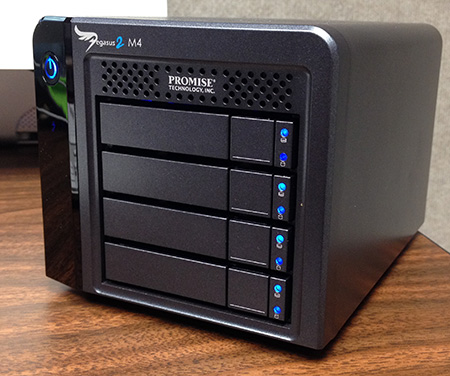 The Promise Pegasus 2 M4 is a small, 4-bay RAID that can be configured with either SSD or standard hard disks. The Pegasus 2 family of RAIDs “offers creative enthusiasts and professionals portable RAID storage for post-production and broadcasting, such as offsite shoots, remote studios, or department workgroups.” (Promise website)
The Promise Pegasus 2 M4 is a small, 4-bay RAID that can be configured with either SSD or standard hard disks. The Pegasus 2 family of RAIDs “offers creative enthusiasts and professionals portable RAID storage for post-production and broadcasting, such as offsite shoots, remote studios, or department workgroups.” (Promise website)
The M4 is designed for portability and, when equipped with SSD drives, serious performance. Using the included Promise Utility, the system can be configured as RAID 0, 1, 5, 6, or 10. Sporting two Thunderbolt 2 ports, it can store up to 4 TB using standard hard drives, or 2 TB using SSD drives. It weighs less than six pounds, is about the size of two coffee mugs, and comes with a 2-year warranty.
If you are looking for something small, light, really fast, and reliable, this is the drive to consider. However, the Promise website highlights data rates exceeding 1300 MB/second. I was not able to come even close to that.
Manufacturer: Promise Technology, Inc.
Website: www.promise.com
MSRP: $1,199 (HD version) $2,499 (SSD version)
Product Webpage: http://www.promise.com/promotion_page/promotion_page.aspx?region=en-US&rsn=167
A COMPARISON
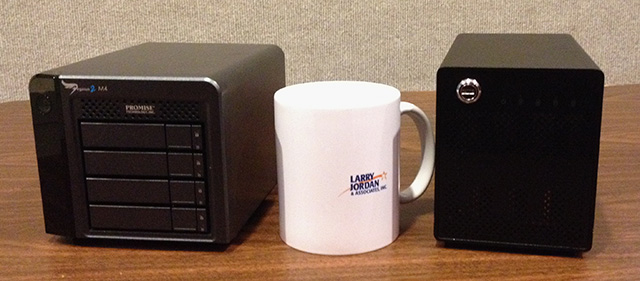
Since I had both the Promise and OWC units here, I thought it would be interesting to compare the two for size. (The Promise is on the left.) The Promise is about an inch wider.
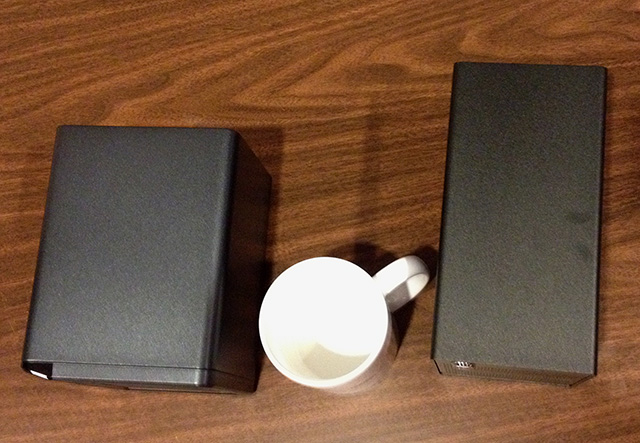
But it is also about an inch-and-a-half less deep.
PACKAGING
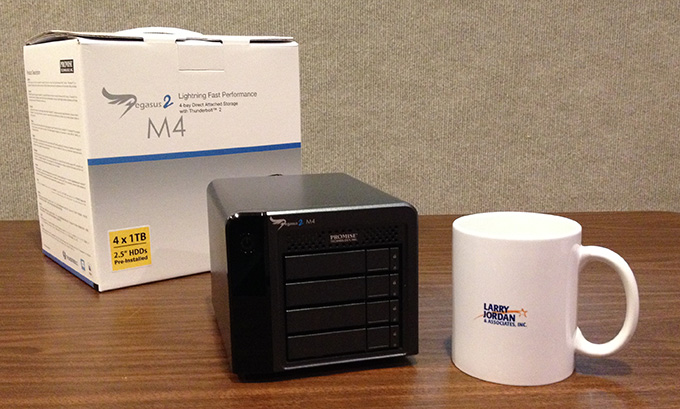
The M4 ships in a nice box and, when unpacked, compares favorably to the size of a coffee mug.
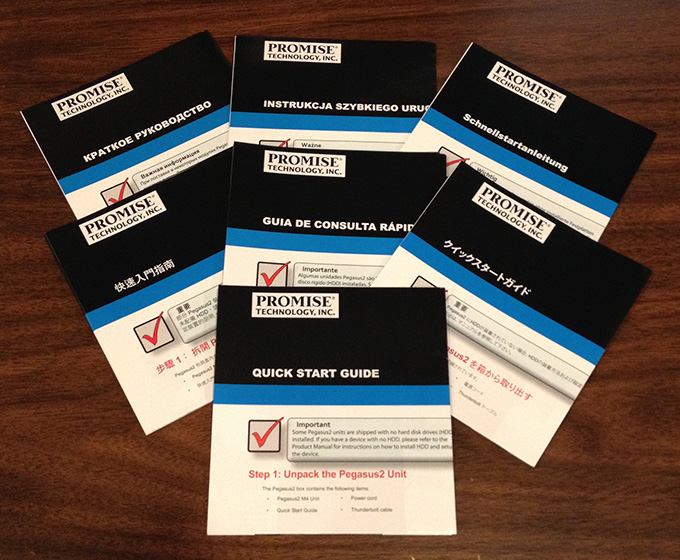
It ships with Quick Start Guides in around 14 languages.
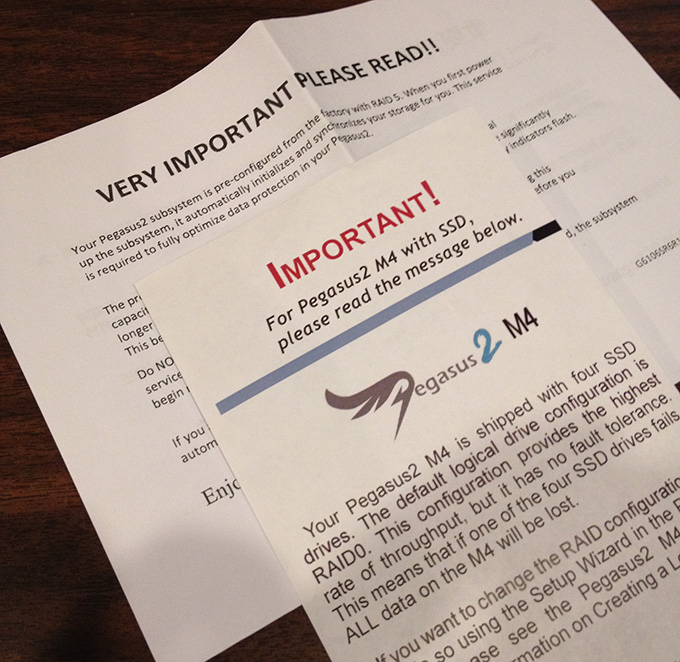
However, Promise seems somewhat confused about how the RAID is configured. The top message says the unit is configured as a RAID 0 and is ready to go. The bottom message clearly states that the unit is configured as RAID 5 and needs several hours to configure and update.
In fact, neither of these two sheets of paper are correct. The unit that I received was configured as a RAID 5 and was ready to go out of the box.
The Quick Start Guides are nice. The two warnings, however, are REALLY confusing!
CONFIGURATION
While the RAID arrives configured as a RAID 5, Promise also ships a free utility: “Promise Utility” that you use to configure the RAID as needed.

System monitoring and configuration starts with the Dashboard.
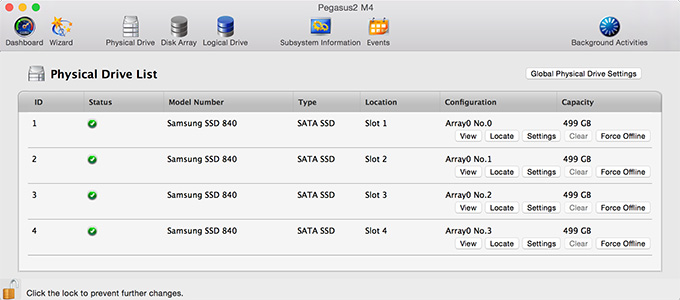
Drives are inspected and formatted in the Physical Drive List panel.

And RAIDs are built using the Logical Drive panel.
Be sure to read the documentation that comes with this utility before using it. If you don’t know what you are doing and don’t pay attention, you can really mess this system up.
NOTE: When I configured the RAID, I used a stripe size of 1 MB. Larger stripe sizes are better for digital video. Smaller stripe sizes are better for general office documents.
SPEED SPECS
NOTE: All testing was done on a 5K iMac running OS X 10.10.1, with 32 GB of RAM.
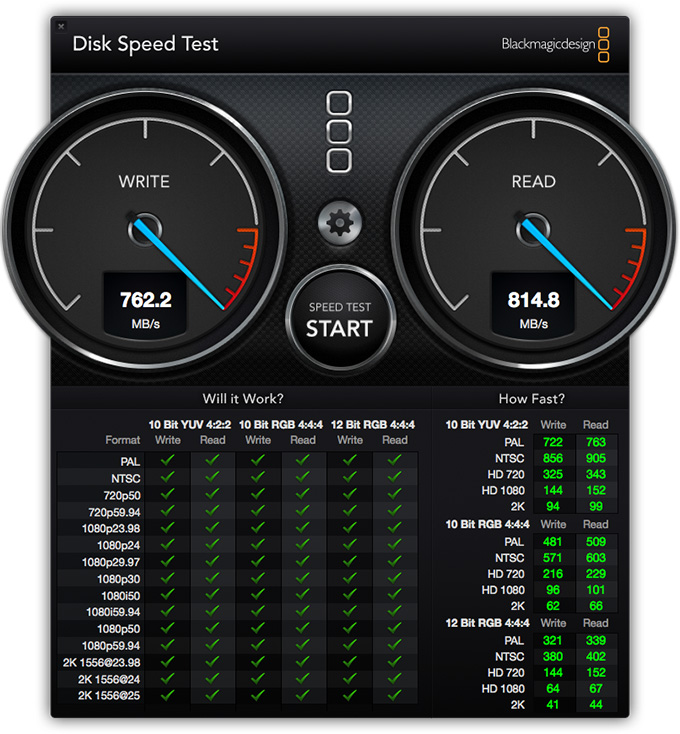
When configured as a RAID 0, which provides the fastest performance, but with no data redundancy, the system delivers amazing speed for a four-bay unit. Unlike the OWC SSD, which uses a software RAID controller, the Promise M4 uses a hardware RAID controller. You can see the difference between them in these numbers.
The green checkboxes indicate which video formats this unit is fast enough to support. In RAID 0, the M4 will support just about anything you care to edit. In RAID 5 (below), it supports virtually every video format except writing high-bit-rate, high-frame-rate formats.
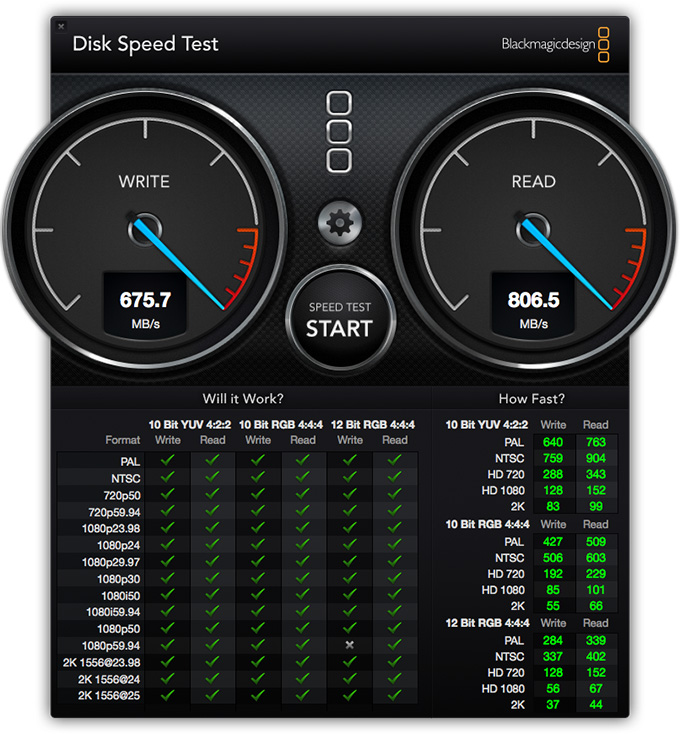
When configured as a RAID 5, performance drops – as you’d expect – but still delivers very respectable numbers.
My recommendation, when using RAIDs, is to configure them as RAID 5. (Other readers suggest RAID 10 and RAID 6 may offer more protection. And, while I agree with their arguments, I’m not willing to accept the greater cost (RAID 10) or slower performance (RAID 6) for editing systems.)
NOTE: Here’s an article that explains RAID levels.
DUPLICATION

Since I had both the OWC and Promise systems, I copied 450 GB between them. I’ll be truthful, speeds like this make me grin. Yes, there are faster RAID systems out there, but not at this price.
MULTICAM
For me, the real test of performance is not the raw speed numbers, but how it handles multicam editing. (I did this testing with the unit configured as a RAID 5.)

For this first test, I built a 16 camera multicam whose clips all used the XDCAM EX format. Since FCP edits this format natively, no media optimization was used.

As you can see, the data load of around 70 MB was easily handled by the M4.
Next, I created an eight-camera multicam clip using ProRes 4444. This is a very heavy format, generating massive files and choking smaller storage systems.

However, during playback, the system easily handled the 280 MB/second load. While more camera streams would increase this the data load, most cameras shoot ProRes 422, which generates much smaller files and are thus easier to handle because their data needs are lower.
In other words, for single camera or multicam editing, the M4 has performance to spare for almost all video formats 2K and below.
SUMMARY
The Promise Pegasus2 M4 RAID is a tremendous performer. It is extremely fast, but like all SSD drives, with very limited storage capacity.
If speed, light weight and ruggedness are more important to you than storage capacity, the Pegasus2 M4 needs to be on your short list of drives to consider.
2,000 Video Training Titles
Edit smarter with Larry Jordan. Available in our store.
Access over 2,000 on-demand video editing courses. Become a member of our Video Training Library today!
Subscribe to Larry's FREE weekly newsletter and
save 10%
on your first purchase.
9 Responses to Product Review: Promise Pegasus2 M4 RAID
Larry,
As I am based in the UK, my first thought in any of your reviews is whether a new device is multi-voltage (110-220v), either switchable in the unit or by the external connector. It’s a small detail, but very useful to know.
Peter:
Good point. All the AV gear I’m seeing these days runs on both 110 and 240 volt systems. The Pegasus has a detachable power cord so you can substitute the plug of your choice.
Larry
Hi Peter,
The internal PSU of the Pegasus2 M4 runs both 110v and 240v and in Europe we deliver the unit with a EU and UK power-cord.
With kind regards,
Dennis op den Buijs
Technical Sales Manager (UK, Benelux and Nordics)
Promise Technology
I run an M4 that I use with 4 1TB EVO 840 Samsung SSD drives. This isn’t a ‘supported configuration’ but I thought it was worth a try because it was actually less expensive to buy the drives separately and install them into a unit that was sold with hard drives, than to buy the SSD unit with half the capacity.
I get better performance testing with BlackMagic utility than you – over 1 GB/sec reads. But what’s amazing is that my in-application performance is actually much higher. While doing disk intensive compositing using Autodesk Flare I’ve seen speed over 1.5GB/sec in the performance monitor. It’s possible that the file system cache is coming into play here. I’m not sure.
The unit has now marked two drives ‘dead’. Both in third tray. One of the drives does indeed appear to be flaky, but the other used outside the unit seems to be fine. So having a spare on hand is mandatory when running an unsupported configuration.
My next step is to build a second unit and try to stripe them together in disk utility. Hoping for near doubling of performance. I’ll try to report back…
How did you get on long term with SSD? I have the M4 but I’m desperate to put SSDs in but only if the data is safe. I’m happy with RAID5 and I’d put the 1Tb EVO 850’s in as I already have 2 so cheaper to just buy 2 more. I don’t use it to it’s full potential at the moment because it’s just not quick enough for 4K with the 2.5″ old school drives.
Jeff:
As long as the Promise is connected via Thunderbolt 2, SSDs will be about twice as fast as a spinning hard disk.
From a data safety point of view, you should be fine.
Larry
Thanks Larry. I find the speeds I get with standard drives all over the place so looking forward to seeing how SSD performs.
hi, can the M4 use larger hard disk drives like 4tb or 5tb ?
Eric:
Any RAID should be able to use any size hard drive. The key is that the size of all drives needs to match.
Larry